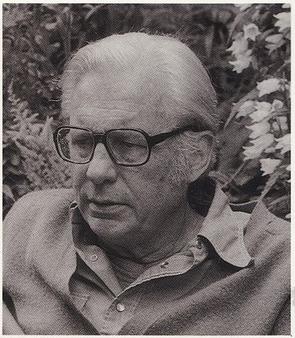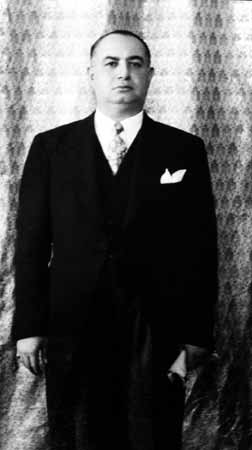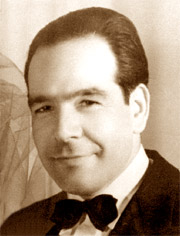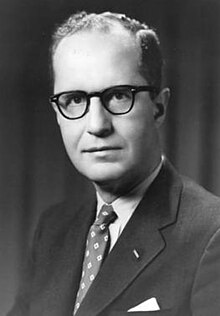
Mohammad Mosaddegh was an Iranian politician, author, and lawyer who served as the 30th Prime Minister of Iran from 1951 to 1953, elected by the 16th Majlis. He was a member of the Iranian parliament from 1923, and served through a contentious 1952 election into the 17th Iranian Majlis, until his government was overthrown in the 1953 Iran coup aided by the intelligence agencies of the United Kingdom (MI6) and the United States (CIA), led by Kermit Roosevelt Jr. His National Front was suppressed from the 1954 election.

The 1953 Iranian coup d'état, known in Iran as the 28 Mordad coup d'état, was the U.S.- and British-instigated, Iranian army-led overthrow of the democratically elected Prime Minister Mohammad Mosaddegh in favor of strengthening the autocratic rule of the shah, Mohammad Reza Pahlavi, on 19 August 1953, with the objectives being to protect British oil interests in Iran after its government refused to concede to western oil demands. It was instigated by the United States and the United Kingdom. This began a period of dissolution for Iranian democracy and society whose effects on civil rights are prevalent to this day.

Christopher Montague Woodhouse, 5th Baron Terrington,, known as C. M. Woodhouse, was a British army SOE officer, MI6 intelligence officer and Conservative politician who served as Member of Parliament (MP) for Oxford from 1959 to 1966 and again from 1970 to 1974. He was also a visiting Fellow at Nuffield College, Oxford, from 1956 to 1964.

All the Shah's Men: An American Coup and the Roots of Middle East Terror is a book written by American journalist Stephen Kinzer. The book discusses the 1953 Iranian coup d'état backed by the U.S. Central Intelligence Agency (CIA) in which Mohammed Mossadegh, Iran's democratically elected prime minister, was overthrown by Islamists supported by American and British agents and royalists loyal to Shah Mohammad Reza Pahlavi.

Miles Axe Copeland Jr. was an American musician, businessman, and Central Intelligence Agency (CIA) founding member best known for his relationship with Egyptian leader Gamal Abdel Nasser and his public commentary on intelligence matters. Copeland participated in numerous covert operations, including the March 1949 Syrian coup d'état and the 1953 Iranian coup d'état.

Husni al-Za'im was a Syrian Kurdish military officer and who was head of state of Syria in 1949. He had been an officer in the Ottoman Army. After France instituted its colonial mandate over Syria after the First World War, he became an officer in the French Army. After Syria's independence in 1946 he was made Chief of Staff, and was ordered to lead the Syrian Army into war with the Israeli Army in the 1948 Arab-Israeli War. The defeat of the Arab league forces in that war shook Syria and undermined confidence in the country's chaotic parliamentary democracy, allowing him to seize power in 1949. However, his reign as head of state was brief, he was tried and executed in August 1949 by his former coup co-conspirators. Al-Za'im infamously executed Lebanese intellectual Antoun Saadeh in July 1949.

Hossein Fatemi was an Iranian scholar. A close associate of Prime Minister Mohammad Mosaddegh, he proposed nationalization of Iranian oil and gas assets. Initially a journalist, he served as minister of foreign affairs from 1951 to 1953. After the 1953 coup d'état toppled the government of Mosaddegh, Fatemi was arrested, tortured, and convicted by a military court of "treason against the Shah", and executed by a firing squad.

Archibald Bulloch Roosevelt Jr., the first grandson of U.S. President Theodore Roosevelt, was a soldier, scholar, polyglot, authority on the Middle East, and career CIA officer. He served as chief of the Central Intelligence Agency's stations in Istanbul, Madrid and London. Roosevelt had a speaking or reading knowledge of at least twenty languages.

Loy Wesley Henderson was a United States Foreign Service Officer and diplomat.

United States foreign policy in the Middle East has its roots in the early 19th-century Tripolitan War that occurred shortly after the 1776 establishment of the United States as an independent sovereign state, but became much more expansive in the aftermath of World War II. With the goal of preventing the Soviet Union from gaining influence in the region during the Cold War, American foreign policy saw the deliverance of extensive support in various forms to anti-communist and anti-Soviet regimes; among the top priorities for the U.S. with regards to this goal was its support for the State of Israel against its Soviet-backed neighbouring Arab countries during the peak of the Arab–Israeli conflict. The U.S. also came to replace the United Kingdom as the main security patron for Saudi Arabia as well as the other Arab states of the Persian Gulf in the 1960s and 1970s in order to ensure, among other goals, a stable flow of oil from the Persian Gulf. As of 2023, the U.S. has diplomatic relations with every country in the Middle East except for Iran, with whom relations were severed after the 1979 Islamic Revolution, and Syria, with whom relations were suspended in 2012 following the outbreak of the Syrian Civil War.
The Central Intelligence Agency (CIA) has repeatedly intervened in the internal affairs of Iran, from the Mosaddegh coup of 1953 to the present day. The CIA is said to have collaborated with the last Shah, Mohammad Reza Pahlavi. Its personnel may have been involved in the Iran-Contra affair of the 1980s. More recently in 2007-8 CIA operatives were claimed to be supporting the Sunni terrorist group Jundallah against Iran, but these claims were refuted by a later investigation.
The United States (U.S.) Central Intelligence Agency (CIA) has been involved in covert actions and contingency planning in Iraq ever since the 1958 overthrow of the Iraqi monarchy, although the historiography of Iraq–United States relations prior to the 1980s is considered relatively underdeveloped, with the first in-depth academic studies being published in the 2010s.
Central Intelligence Agency activities in Syria since the agency's inception in 1947 have included coup attempts and assassination plots, and in more recent years, extraordinary renditions, a paramilitary strike, and funding and military training of forces opposed to the current government.
The American Friends of the Middle East (AFME) was an American international educational organization, formed in 1951. It was founded by columnist Dorothy Thompson, Kermit Roosevelt, Jr., Harry Emerson Fosdick, and 24 other American educators, theologians, and writers. The predecessor organization, with many of the same founders was the Committee for Justice and Peace in the Holy Land. The AFME organization was later linked to the Central Intelligence Agency (CIA). It existed as a pro-Arabist organization often critical of U.S. support for Israel.

Abdel Hamid Sarraj was a Syrian Army officer and politician. When the union between Egypt and Syria was declared, Sarraj, a staunch Arab nationalist and supporter of Egyptian president Gamal Abdel Nasser, played a key role in the leadership of the Syrian region of the UAR. Due to the repression by the UAR of the Syrian communists he was nicknamed Sultan Abdel Hamid referring to the Ottoman sultan Abdul Hamid II.
The March 1949 Syrian coup d'état was a bloodless coup d'état that took place on 30 March. It was the first military coup in modern Syrian history and overthrew the country's democratically-elected government. It was led by the Syrian Army chief of staff, Husni al-Za'im, who became president of Syria on 11 April 1949. Among the officers who assisted al-Za'im's takeover were Sami al-Hinnawi and Adib al-Shishakli, both of whom in sequence would later also become military leaders of the country. Syrian President Shukri al-Quwatli, was accused of purchasing inferior arms for the Syrian Army and poor leadership. He was briefly imprisoned, but then released into exile in Egypt. Syria's legislature, then called the House of Representatives, was dissolved. al-Za'im also imprisoned many political leaders, such as Munir al-Ajlani, whom he accused of conspiring to overthrow the republic.
James Hugh Keeley Jr. was an American diplomat.
Since the 19th century, the United States government has participated and interfered, both overtly and covertly, in the replacement of many foreign governments. In the latter half of the 19th century, the U.S. government initiated actions for regime change mainly in Latin America and the southwest Pacific, including the Spanish–American and Philippine–American wars. At the onset of the 20th century, the United States shaped or installed governments in many countries around the world, including neighbors Hawaii, Panama, Nicaragua, Mexico, Haiti, and the Dominican Republic.
Project FF or Fat Fucker was a Central Intelligence Agency (CIA) project aimed at pressuring King Farouk of Egypt to make political reforms that would lessen the likelihood of violent political change in the country contrary to American interests. The government of the United States was concerned that the ever-increasing political instability in Egypt, much of it linked to the perceived corruption and incompetence of both the royal court and the traditional political establishment, would inevitably result in the toppling of the Egyptian government if not remedied. In particular, they feared the prospect of a partial or full communist takeover. The project was masterminded by CIA Director Allen Dulles, Secretary of State Dean Acheson, CIA operative Kermit "Kim" Roosevelt Jr., and CIA Station Chief in Cairo Miles Copeland, Jr.

Norman Darbyshire (1924–1993) was a British spy who worked for the SOE and the MI6. He played a key role in the 1953 coup d'état that overthrew Mohammed Mossadegh, the democratically-elected prime minister of Iran.














